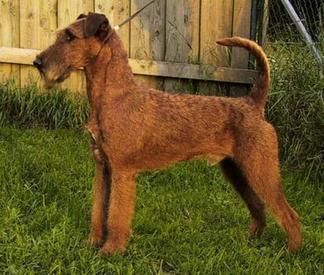
The Irish Terrier originates from...
First shown in 1875 at a Glasgow dog show, the Irish Terrier rose to considerable popularity, being registered as the fourth most popular dog in England in the 1880s. Primarily bred for the purpose of hunting den animals including water rats and otters, the Irish Terrier established a concrete reputation as an accomplished and willing hunter, ridding food stores and farmsteads of vermin. Thought to boast an ancient lineage that dates back over 2,000 years, the Irish Terrier was first recognised by the American Kennel Club in 1885. Bred for its working qualities and gameness rather than appearance, the Terrier was widely enlisted during WWI as a sentinel and messenger dog, tracking back and forth through shellfire to reach its recipient.
The Irish Terrier is characterised by...
Often likened in appearance and structure to the Airedale Terrier, the Irish Terrier is distinctive and functional, characterised by a medium build, a bearded muzzle, high-set tail, triangular 'drop' ears, and a wiry outer coat in common colour variations of black, tan, and grizzle. Despite being an illegal practice in most countries across Europe, tail 'docking' is often carried out with this breed, although it is not a breed standard. Traditionally employed in hunting fox, otter, badger, weasel, and rats, they retain their natural instincts, inclined to chase smaller animals unless trained not to. Often nicknamed the 'daredevil,' this dog is believed to be one of the oldest of the Terrier family.
The average Irish Terrier...
Compatible with children and other domestic animals, the Irish Terrier is a great breed choice for families or a dedicated sole owner. Inherently energetic and fun-loving, they require regular exercise and mental enrichment. Highly intelligent and responsive, the breed can be trained to a good degree. On average, a healthy Irish will weigh 11-12kg depending on its gender, with a life expectancy of 12-15 years when shown the appropriate care. It is not uncommon for an Irish to outlive this expectancy.
Weaknesses...
Selectively bred for its hardy capabilities, the Irish is typically healthy and long-lived. As with most other breeds the Irish is prone to certain afflictions including optical disorders, dermatitis, and hip dysplasia. No serious breed-specific or genetic diseases are documented for the breed.
Browse more breed facts and information or take a look at our dog toys and dog collars and leads.
Do you own a Irish Terrier? Let others know what they're like!
Related products
KONG Anxiety Reducing Shirt for Dogs
from £17.30
Hurtta Rain Blocker ECO
from £89.99
Advantage 80 Spot On Flea Control Large Cats and Rabbits
from £12.95
Advantage 40 Spot On Flea Control Cats, Small Dogs and Rabbits
from £12.95
Advantage 100 Spot On Flea Control Medium Dog
from £12.95
Advantage 250 Spot On Flea Control Large Dog
from £12.95
Drontal Tasty Bone Wormer Tablets for Small & Medium Dogs (2 to 20kg)
from £1.83
FRONTLINE Plus Flea & Tick Treatment Dogs & Cats
from £17.49